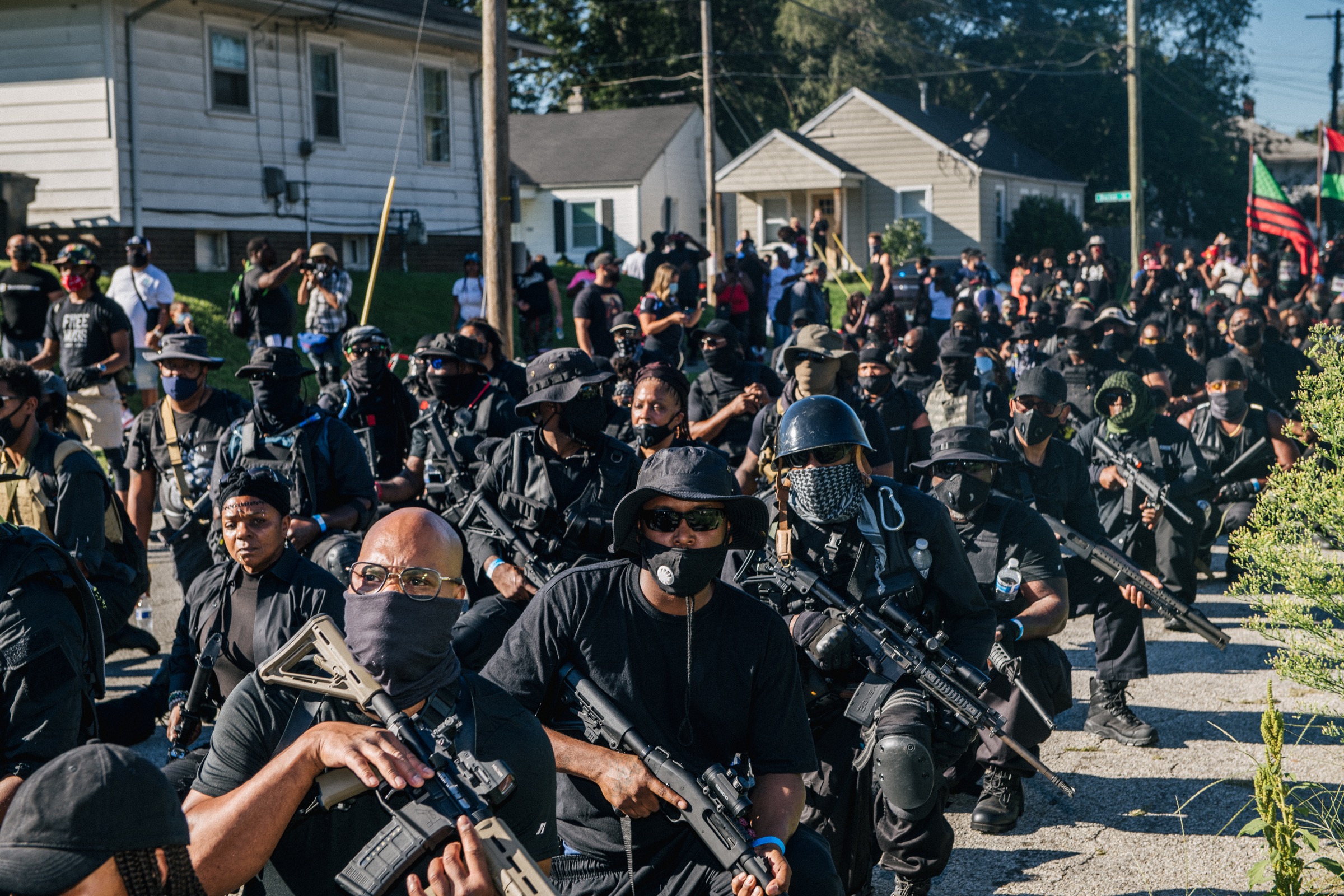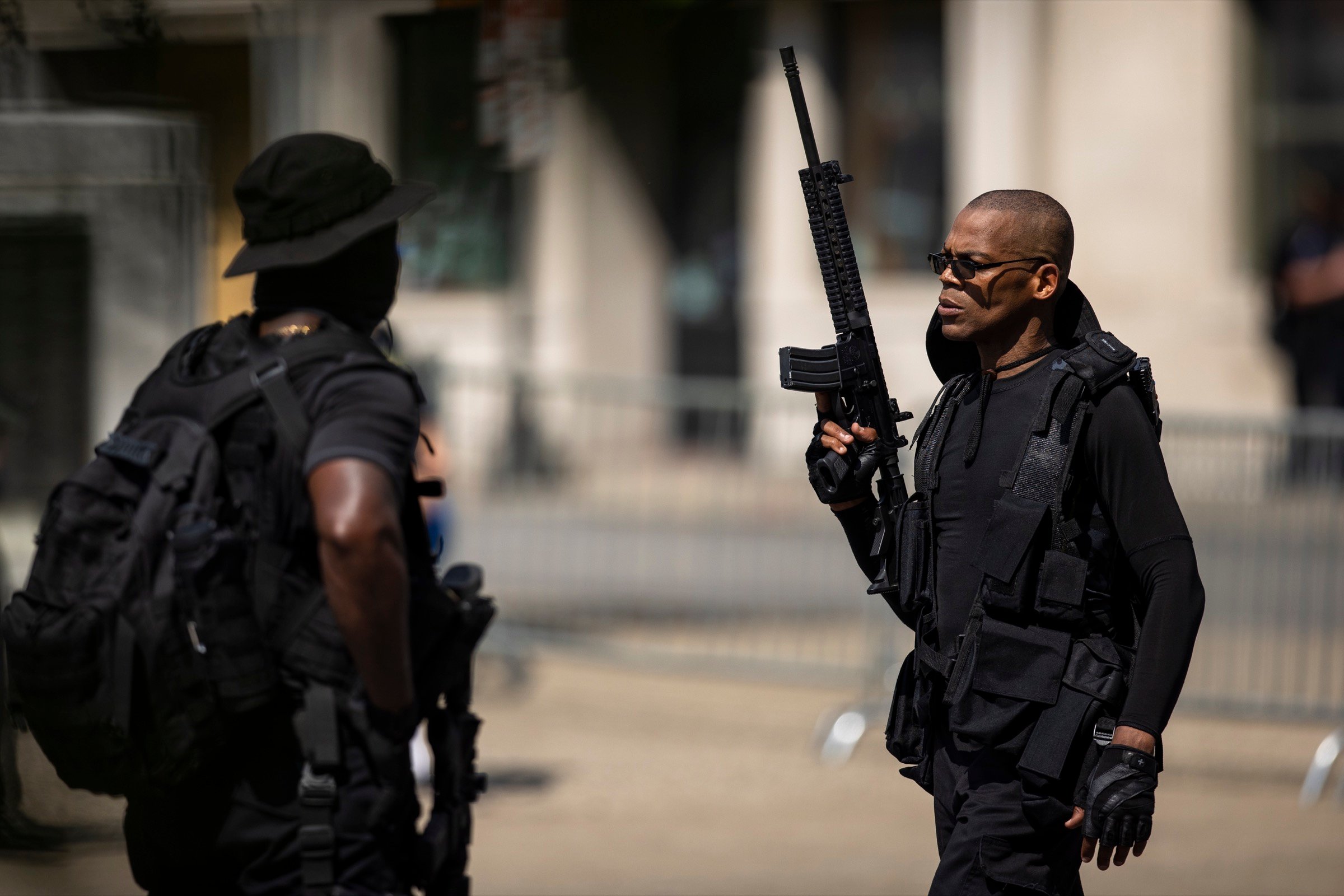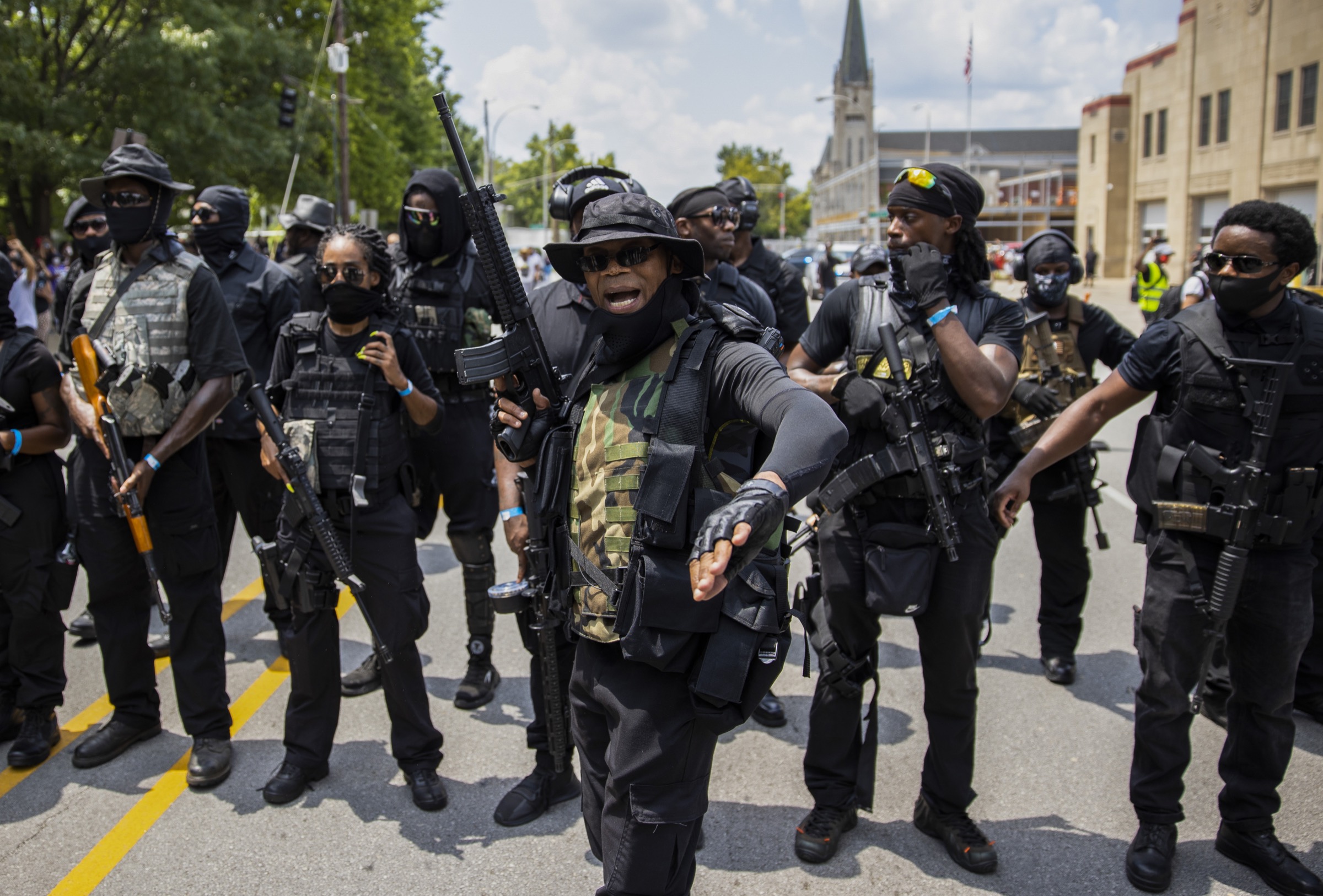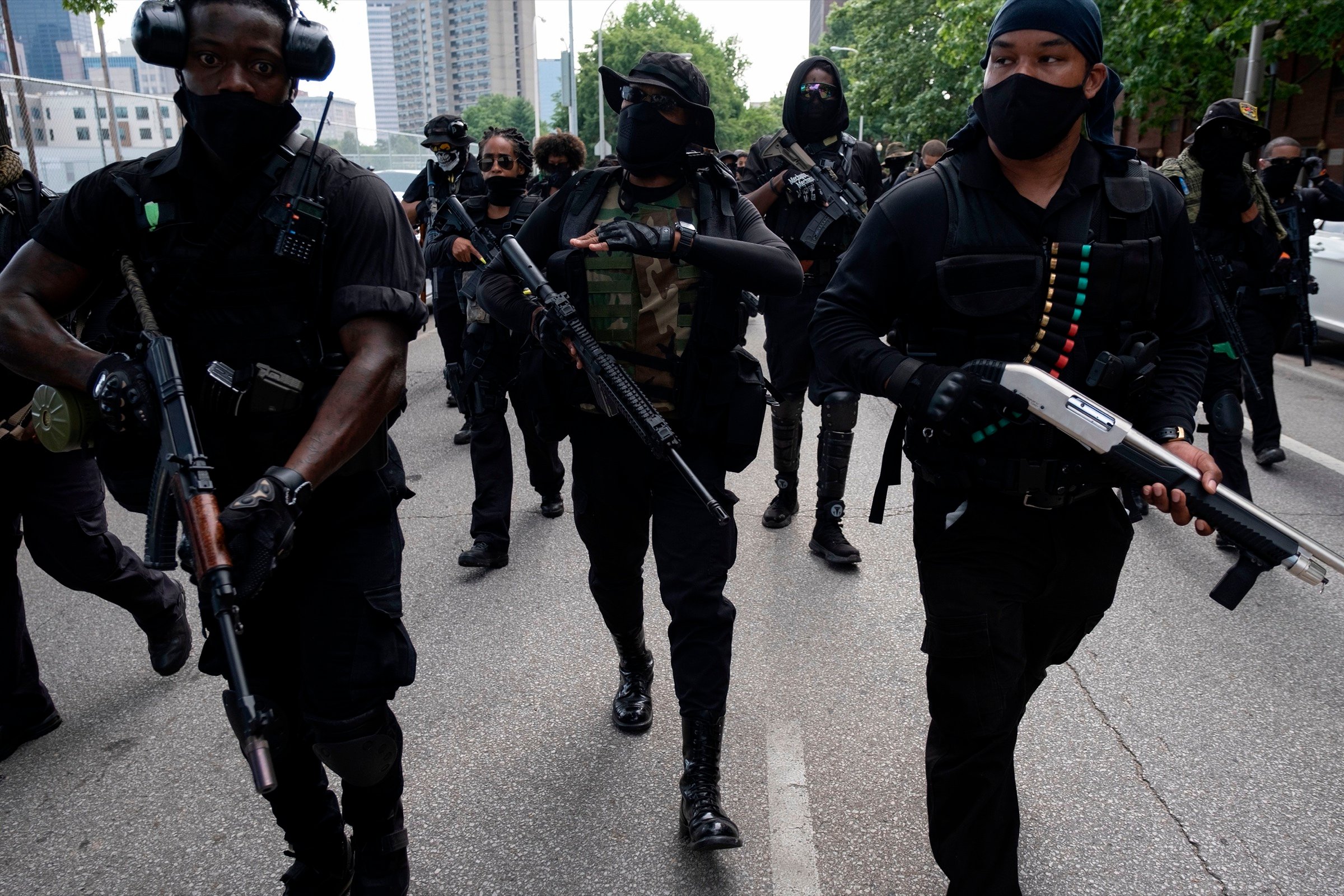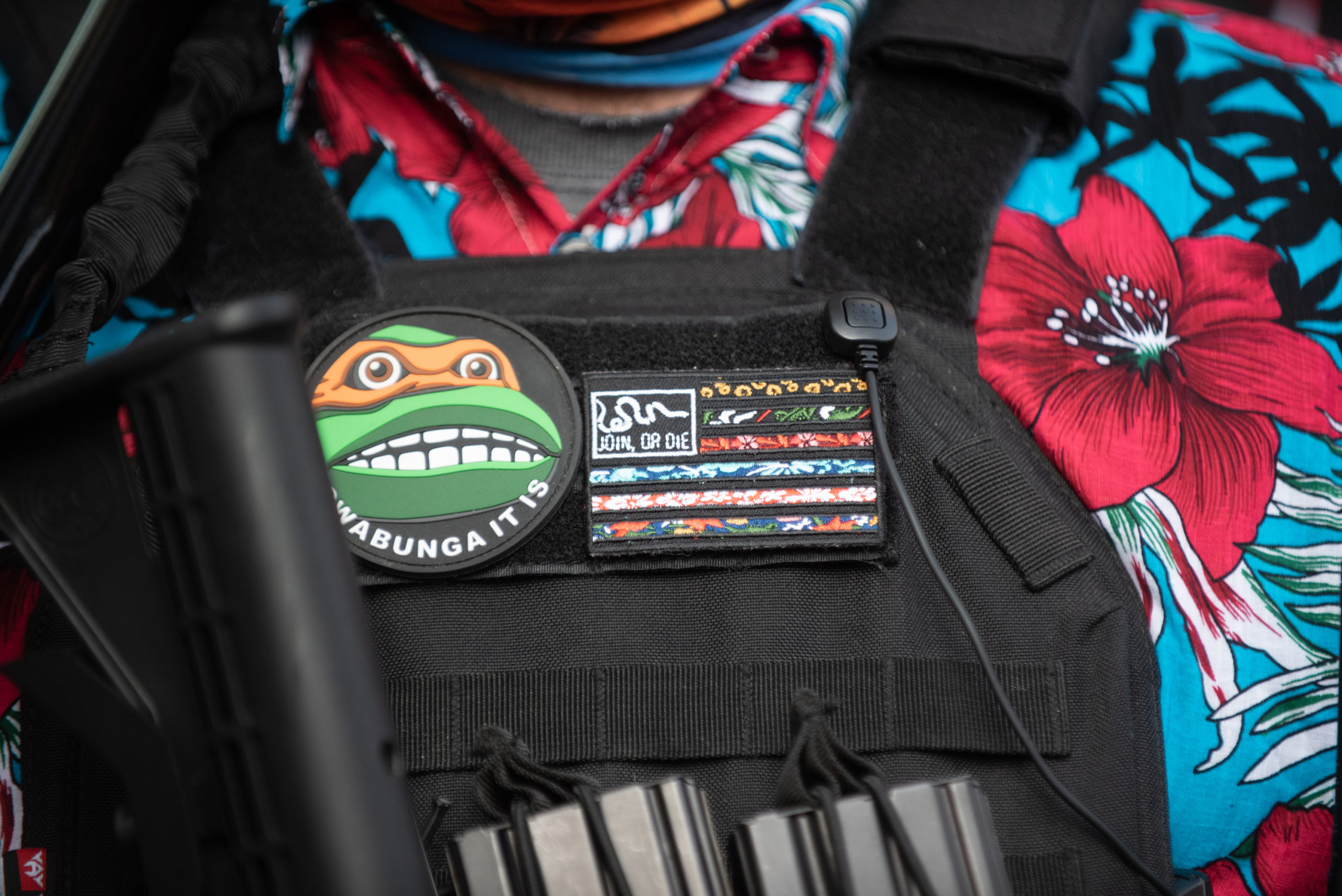In late July 2020, as Louisville, Kentucky, fumed in the wake of Breonna Taylor’s killing in a botched police raid, a militia group descended on the city.
A phalanx of hundreds of Black men and women, all clad in black, marched through downtown. Some wore body armor, others had gas masks. They wore pistols on their belts and carried shotguns and AR-15-style rifles.
It was the latest rally of the Not Fucking Around Coalition, an armed group that says it’s dedicated to protecting Black lives from police brutality. And it got the attention of experts who track extremist movements.
“It was the biggest public display by an armed militia I have ever seen,” said J.J. MacNab, a fellow at George Washington University’s Program on Extremism who has studied the militia movement for 25 years. “Nobody was expecting that.”
A year later, NFAC, as the group is known, was back in Louisville. Its leader, Grandmaster Jay, whose real name is John Fitzgerald Johnson, retained the cocky, steel-eyed confidence that has made him a messiah to tens of thousands of Black Americans. He wore his trademark body armor and sunglasses in the summer heat and spoke grandly of self-defense, Black empowerment and the creation of a Black nation.
This time there was no march before a cheering crowd. The guns were nowhere to be seen. Grandmaster Jay’s troops had shrunk to a small crew of loyalists.
Everyone there knew why: Months after a second rally in Louisville, Grandmaster Jay had been charged with “assaulting, resisting or impeding” officers while brandishing a firearm.
That September night, federal prosecutors claim, Grandmaster Jay aimed his rifle at a group of officers conducting surveillance on a rooftop. He faces three to 27 years in prison if convicted of the charges.
Since he was arrested, the pandemic has raged and the police reform movement has cooled. A judge has barred Grandmaster Jay from possessing a gun while he awaits trial. He can’t access social media, cutting him off from perhaps a more powerful weapon.
No longer can he use his twice-daily Instagram shows to rouse hundreds of troops with impassioned calls to arms. Instead, he relies on phone calls and emails.
Grandmaster Jay won’t talk much about what happened that night, though he said he had a flashlight mounted to his rifle, which he usually carries pointed upwards. He maintains he’s just the latest Black leader to pick up a gun, only to be quickly targeted by a federal government with a history of suppressing African-American groups that dare to challenge the status quo.
“You put me back in the cave,” he said in an interview with USA TODAY and The Trace. “It was a methodology used to silence a very powerful voice in the world.”
While his organization has marched peacefully and respectfully, he said, mostly white groups have intimidated protesters and barged into government buildings carrying weapons, with little interference from police.
In certain cases in which white militia groups have confronted law enforcement directly – such as the armed stand-off at the Malheur National Wildlife Refuge in Oregon in 2016 – the feds have pounced on them. Recently, white members of militia groups have been charged after bringing weapons to demonstrations and altercations around the country.
Nonetheless, the federal government’s case against Grandmaster Jay follows a longstanding pattern of clampdowns on Black Americans who arm themselves. From slave uprisings in the 1800s to the Black Panthers in the 1960s to NFAC in 2020, the game plan is always the same, said Arjun Sethi, an author and law professor at Georgetown University Law Center.
“When Black folks in America pick up weapons, a different set of rules has always applied,” Sethi said. “That was the case 100 years ago; that remains the case today.”
Some law enforcement and militia movement experts said prosecutors are right to pursue charges against Grandmaster Jay. He’s a dangerous man, they say, who commands an army of agitators.
When Black folks in America pick up weapons, a different set of rules has always applied. That was the case 100 years ago; that remains the case today.
Arjun Sethi, author and Georgetown law professor
In online videos, Grandmaster Jay has called for his followers to meet police and white supremacist violence with violence. After George Floyd, a Black man, was murdered by Minneapolis police officer Derek Chauvin, the NFAC leader issued a threat apparently directed at officers like him.
“If you kill us, we will kill you, point f—ing blank,” he said in a video. “If we can’t get to you, we’re gonna go after your family members. If we can’t get them, we’re gonna go after your church members. If we can’t get them, we’re gonna go after your co-workers. If we can’t get them, f— it, we’ll just go after anybody.”
Unlike white militias, which feed off misinformation and unfounded conspiracy theories, the fuel for NFAC’s fire has been on display for anyone to see.
Floyd was killed as the nation was grappling with the frequency with which Black men die at the hands of police officers. Since 2015, 137 unarmed Black people have been fatally shot by police, according to The Washington Post. Meanwhile, white supremacist groups flourished and hate crimes against nonwhite victims rose.
It was in this environment of racial reckoning that NFAC was born. And quickly muzzled.
What does NFAC want?
The identity, goals and philosophy of NFAC are inexorably tied to those of Grandmaster Jay.
Though he seldom grants in-depth interviews, he gave access to USA TODAY and The Trace over a weekend marking the one-year anniversary of NFAC’s big moment in Louisville.
In person, the former soldier, DJ and fringe presidential candidate is combative yet charismatic. He seldom smiles and talks in rapid, polished sentences, rounded off with quotes from philosophers, the Bible, and hip-hop.
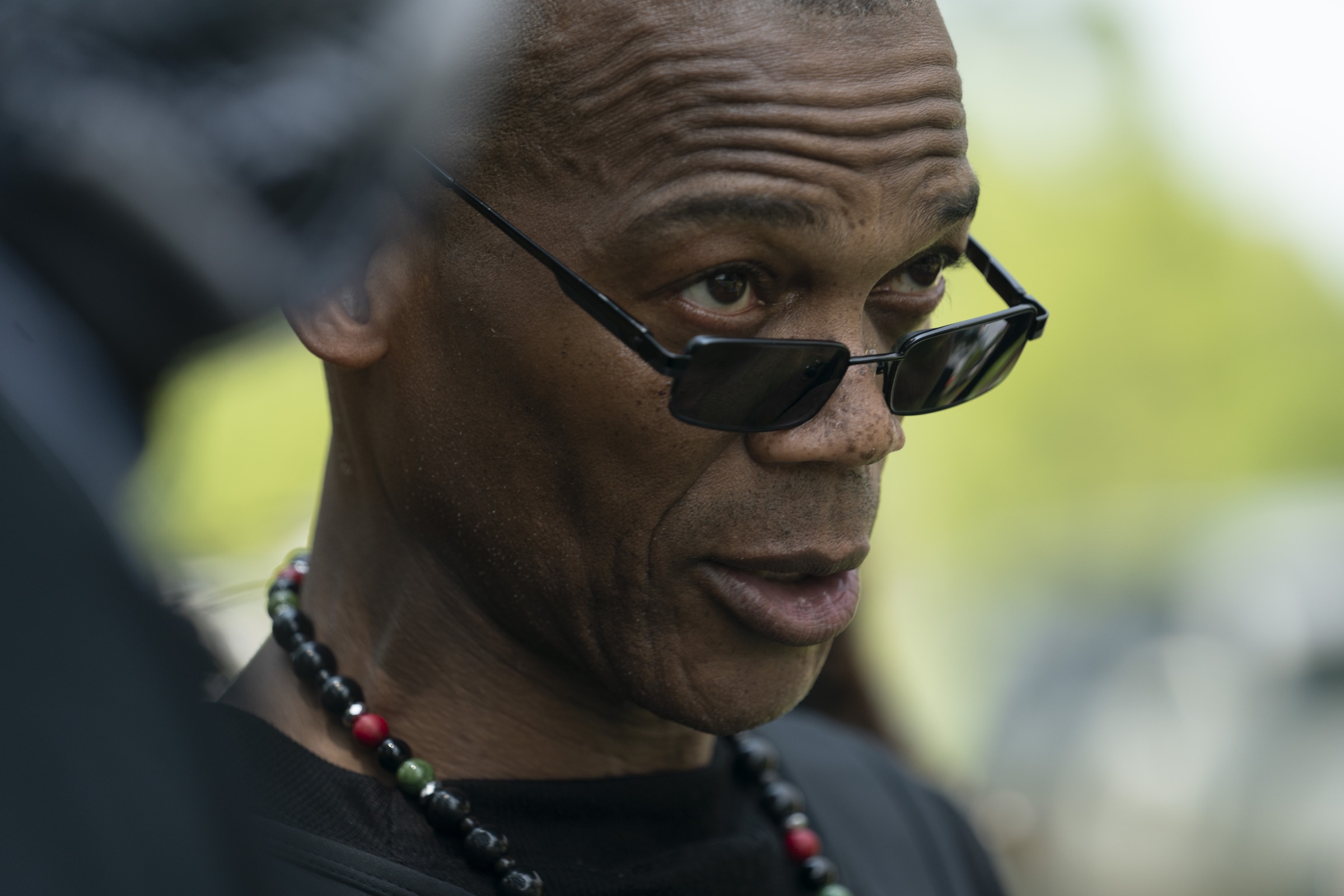
In a series of interviews, Grandmaster Jay refused to deviate to subjects he said were off limits. When he wants to end a line of questioning, he rocks back, peers over his jet-black sunglasses, and stares you down.
He spoke vaguely of NFAC’s founding, confirming only that the first public appearance by the group was in May 2019 in Dayton, Ohio, to protest a Ku Klux Klan rally. He wouldn’t disclose how many members the group has beyond claiming millions of followers worldwide. Experts in militia groups confess they know little about the group, but they said these claims are wildly exaggerated.
Over that weekend in Louisville, Grandmaster Jay laid out NFAC’s mission, saying his primary goal is to educate Black Americans about their constitutional rights. He said he’s not interested in fomenting racial discord or revolution.
“We’re not trying to drive anything; we don’t have a political point,” he said. “We’re neither left-wing, nor right-wing. We don’t have an enemy, per se. We realize that our people need some type of protection because those folks that are being paid to protect us, in our perception, are not doing the job.”
Guns are central to NFAC’s ethos. “When you pick up a weapon… you go from being a subject to a citizen, just like that,” he told the crowd in Louisville in July 2020.
That summer, as communities around the country protested police brutality, especially against Black Americans, NFAC showed up at demonstrations throughout the South. Regimented marches with loaded firearms ended with Grandmaster Jay’s fiery speeches in which he called on Black Americans to arm themselves against white supremacists and the police.
Led by NFAC, he said in an interview, Black America should create its own nation – a nation within a nation – that could sue the United States government for reparations.
“As long as you’re a citizen, you can’t sue yourself,” he said. “So stop asking the very people that you’re a part of to pay you. Doing that means they still own you – and last time I checked, we’re not owned anymore.”
Grandmaster Jay chooses his words more carefully since he was indicted.
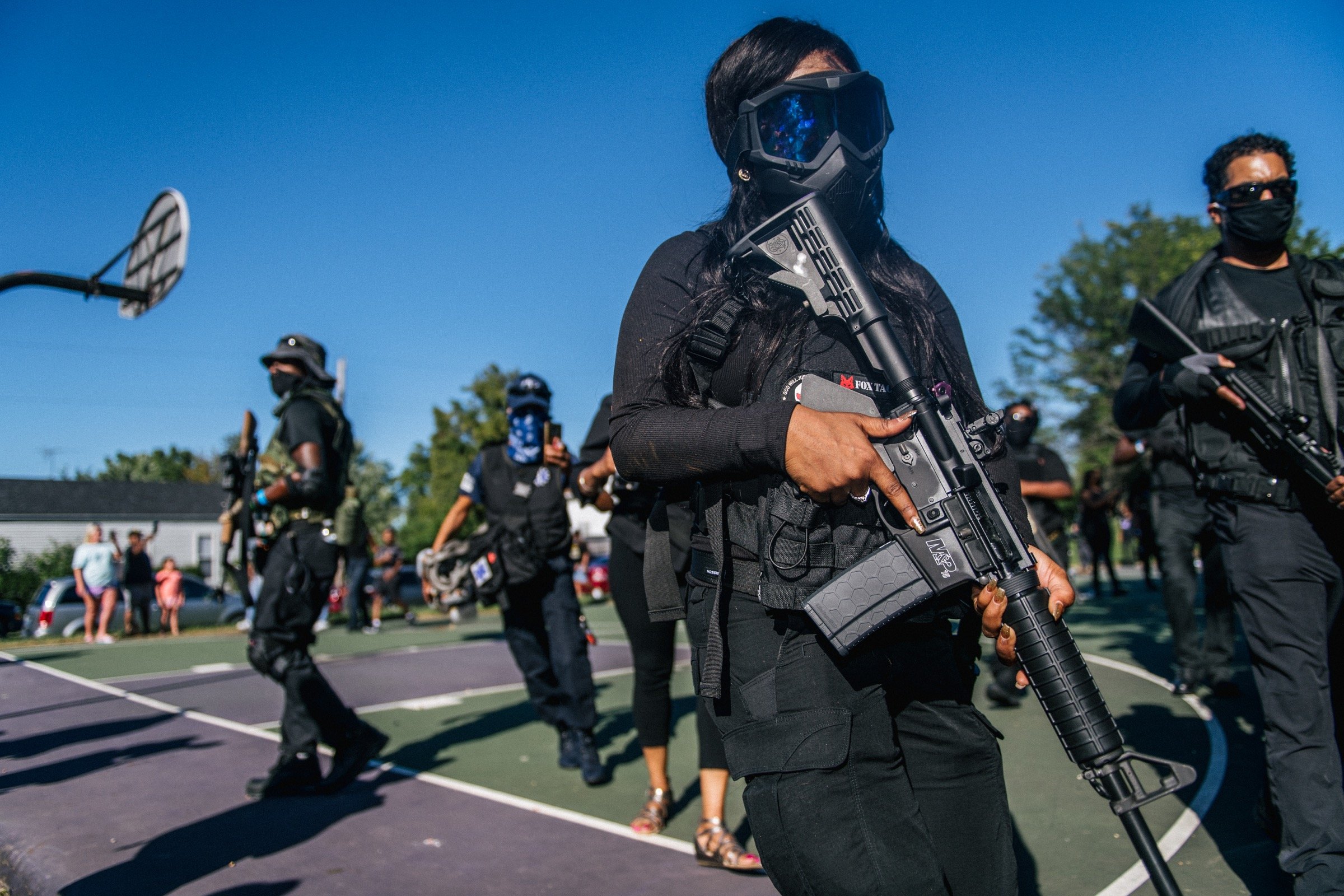
In addition to angry videos he recorded in the wake of Floyd’s murder, the NFAC leader attracted attention last summer when he called on his followers to burn Louisville down if Taylor’s killers weren’t arrested within four weeks.
“It ain’t no fun when the rabbit got the gun, and we don’t hop for nobody,” he told the crowd gathered in front of Metro Hall, the center of city government. “My people will defend themselves if attacked. … I will say it publicly, we won’t shoot you – we will kill you.”
Beyond his incendiary speeches, Grandmaster Jay has drawn fire for pejorative comments, including antisemitism. In an interview, he denied being antisemitic.
One man with NFAC ties has turned violent.
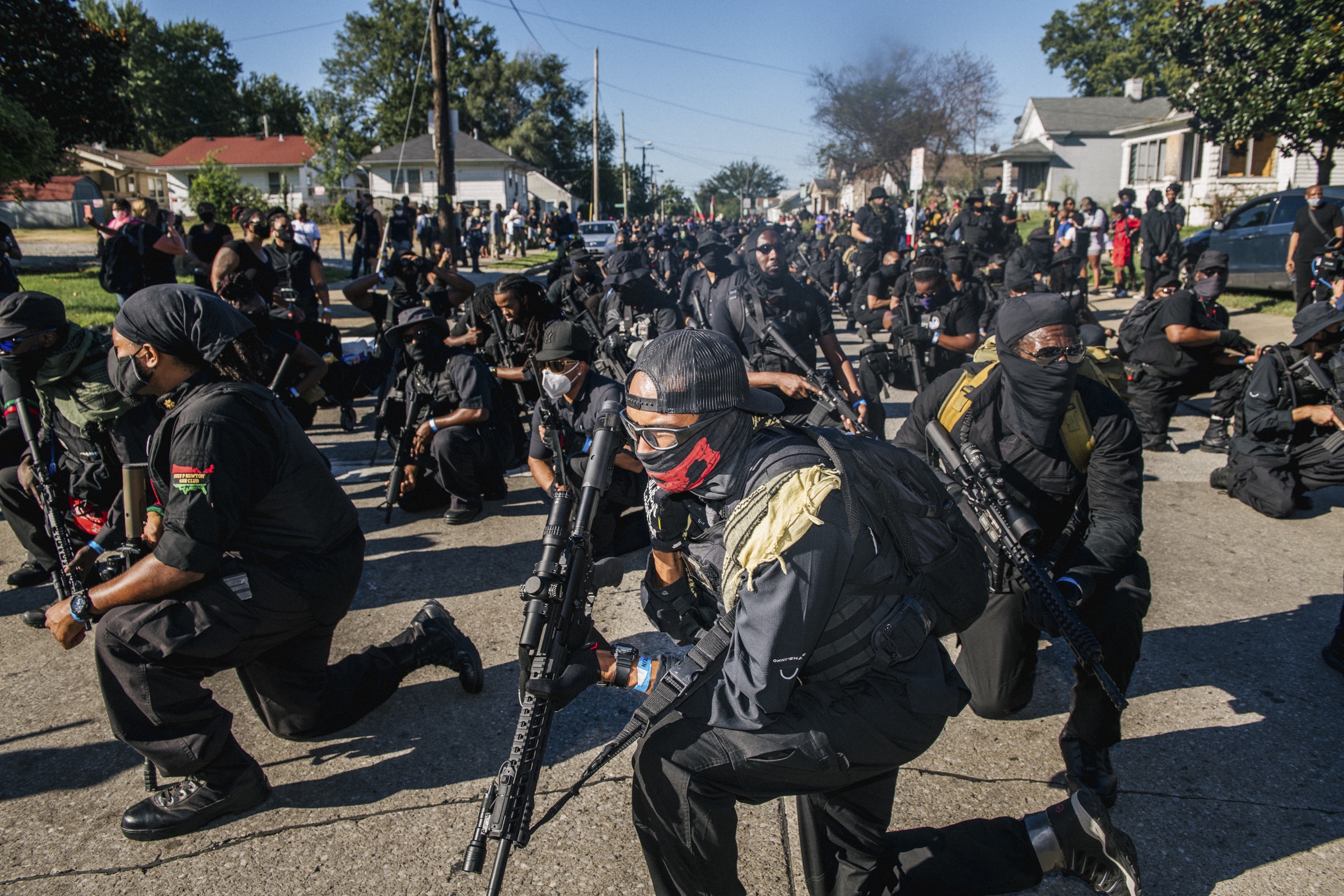
In June, police arrested Othal Wallace at a property in Georgia they said was affiliated with NFAC. Wallace, who was involved with extremist and anti-police groups, was charged with murder in connection with the killing of a Florida police officer.
Grandmaster Jay disavowed Wallace, saying he had left NFAC months before. Despite multiple inquiries, local and federal police agencies did not provide any evidence that the group is tied to the property where he was arrested.
In court documents and interviews, Grandmaster Jay said his occasional angry outbursts shouldn’t outweigh the hundreds of times he has argued for self-defense, peaceful protest, and resorting to violence only as a last resort.
“America’s racism is on full display at this point,” he said. “We are law-abiding citizens, legally assembled. We don’t have an anti-police theology like the groups from the ’60s. We don’t call police ‘pigs.’ We’re not out to get anyone. We’re defensive, and we always have been.”
Aiming a rifle, or using a flashlight?
Prosecutors claim Grandmaster Jay’s posture turned offensive on the evening of Sept. 4, 2020, in downtown Louisville.
Before the rally, according to the criminal complaint, the NFAC leader was warned several times by law enforcement that officers would be stationed on rooftops. He was told not to let anybody point their weapons at them.
That evening, a team of Louisville Police officers took up a position on the roof of a government building, the complaint states. They were there to observe a group of “six to eight heavily armed individuals,” one of whom they recognized as Grandmaster Jay.
The officers allege that they were blinded by a flashlight attached to Grandmaster Jay’s rifle as he pointed it at them. They took cover because they “perceived a threat,” according to the criminal complaint.
Patrick Cotter, a former federal prosecutor in Chicago who has practiced criminal law for 40 years, said this is where the government’s case gets shaky.
The officers didn’t respond the way police officers are trained: by raising their weapons and informing the assailant to lower his gun, or shooting him, Cotter said.
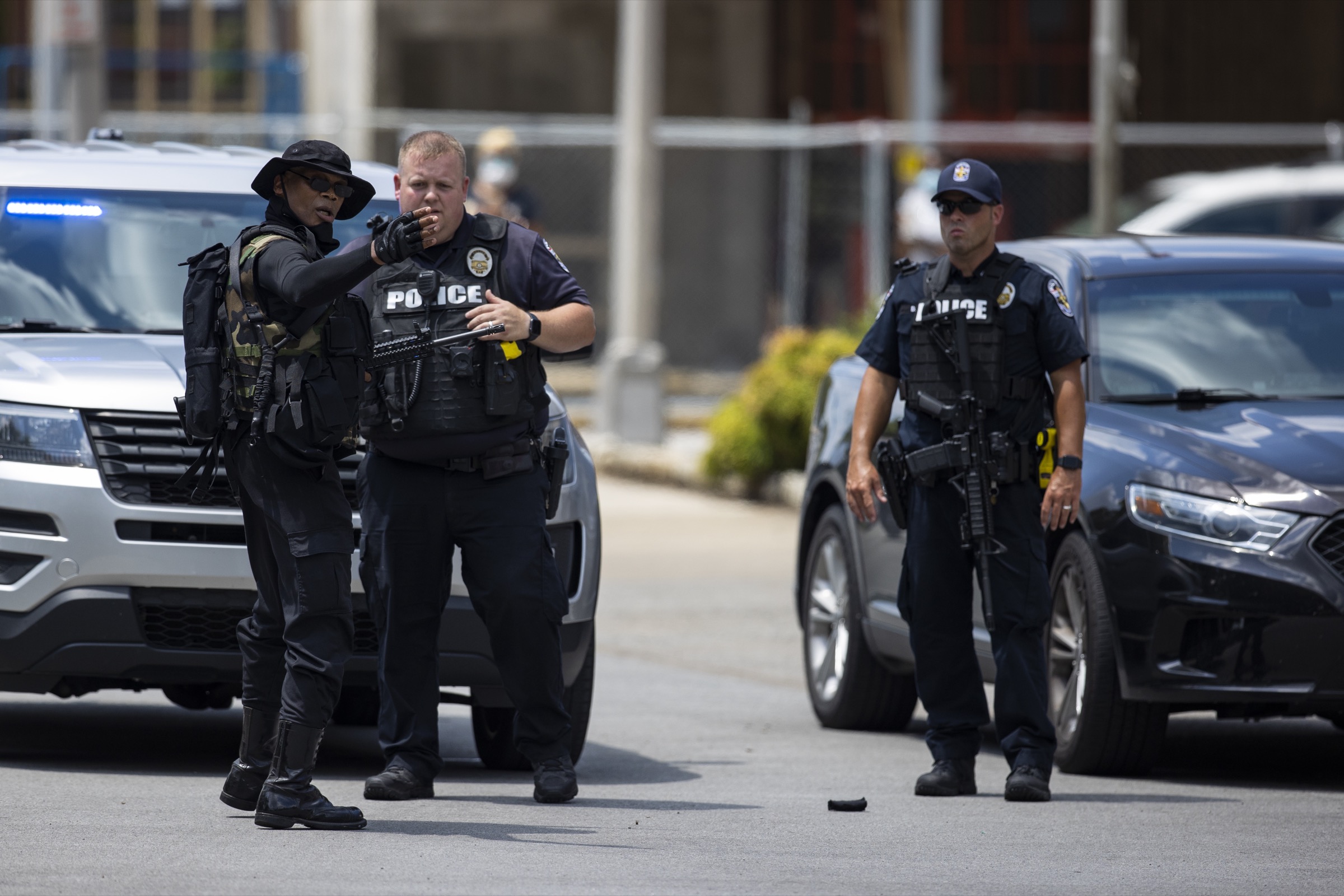
“They did nothing that a trained police officer would do if they actually believed that a person was aiming a powerful rifle at their heads,” he said. “No officer is trained that if you see a guy pointing a high-powered rifle at your head, the thing to do is to duck and then, some time later, swear out a complaint that he was intimidating you.”

According to the filing, a civilian employee of the Louisville Metro Police Department exited a nearby building about 30 seconds later and met with Grandmaster Jay. The criminal complaint indicates the officers did nothing to mitigate the risk Grandmaster Jay apparently posed, Cotter said.
The protest ended without incident.
Over the course of 2020, Louisville Police arrested nearly 1,000 people at protests against police brutality. In Grandmaster Jay’s case, prosecutors used the officers’ accounts as the basis of the charges lodged against him three months later.
A leader cut off from his army
Grandmaster Jay called on prosecutors to drop the charges and allow him to sign back on to social media. Instagram removed his account several months after he was charged, he said, cutting him off from 125,000 followers.
“I could never understand why allegedly pointing a flashlight at someone, whether it was mounted on a gun or a banana, has anything to do with my social media,” he said.
Court-issued social media bans aren’t common, but they’re not unheard of, Cotter said. Some of the defendants in the Capitol riot have been barred from social media while they await trial, but others continue to post.
Enrique Tarrio, the national chairman of the Proud Boys extremist group, continued posting on the messaging service Telegram right up to the day he showed up to serve a jail sentence last month for burning a Black Lives Matter banner.
John Kirby, a former federal prosecutor in San Diego, said prosecutors are likely using the case to neutralize what they see as a growing threat in Grandmaster Jay and NFAC.
In Kirby’s view, the facts are simple: Grandmaster Jay, a man with a criminal history, aimed a gun at law enforcement officers, which is illegal. “I think this is actually a pretty strong case,” he said.
The NFAC leader has been arrested twice, according to prosecutors. A 1995 charge stemming from an incident at a bar was dropped for lack of evidence, according to court documents. In 2003, he was accused of using a rifle to threaten his then-wife and a man with whom Grandmaster Jay said she was having an affair. He pleaded guilty to trespassing and paid a small fine, according to court documents.
Grandmaster Jay has been other-than-honorably discharged from the military twice, both times in lieu of facing a court-martial, prosecutors said in the criminal complaint related to the September rally.
Federal prosecutors are always trying to dismantle organizations that are perceived to be a threat, whether it’s a drug cartel or this guy and his organization.
John Kirby, former federal prosecutor in San Diego
“Federal prosecutors are always trying to dismantle organizations that are perceived to be a threat, whether it’s a drug cartel or this guy and his organization,” Kirby said.
The U.S. Attorney’s Office for the Western District of Kentucky, which filed the charges, declined to comment on the case.
That willingness to use a criminal indictment to clamp down on an organization that threatens the American establishment troubles several experts who have examined Grandmaster Jay’s case.
Coming after months of nationwide protests over police brutality against Black people, the prosecution of a Black militia leader in a Southern state has to be considered in a broader racial context, those experts said.
“Those in power know full well that Black rebellion and Black uprising is more than understandable and legitimate. And I think that is why the state is always wary,” said Eric Tang, a professor of African diaspora studies at the University of Texas at Austin.
A history of clamping down on Black gun ownership
Black gun ownership in America is steeped in cultural and legal discrimination.
From the colonial period until the end of slavery in 1865, scholars estimate there were nearly 300 slave rebellions – many of them armed. In an attempt to curtail the security threat posed by Black slaves, the nation instituted race-based gun laws, many of which banned free and enslaved Black people from possessing firearms.
After the 13th Amendment abolished slavery, overtly racist legislation was replaced with other means to deter Black communities from arming themselves.
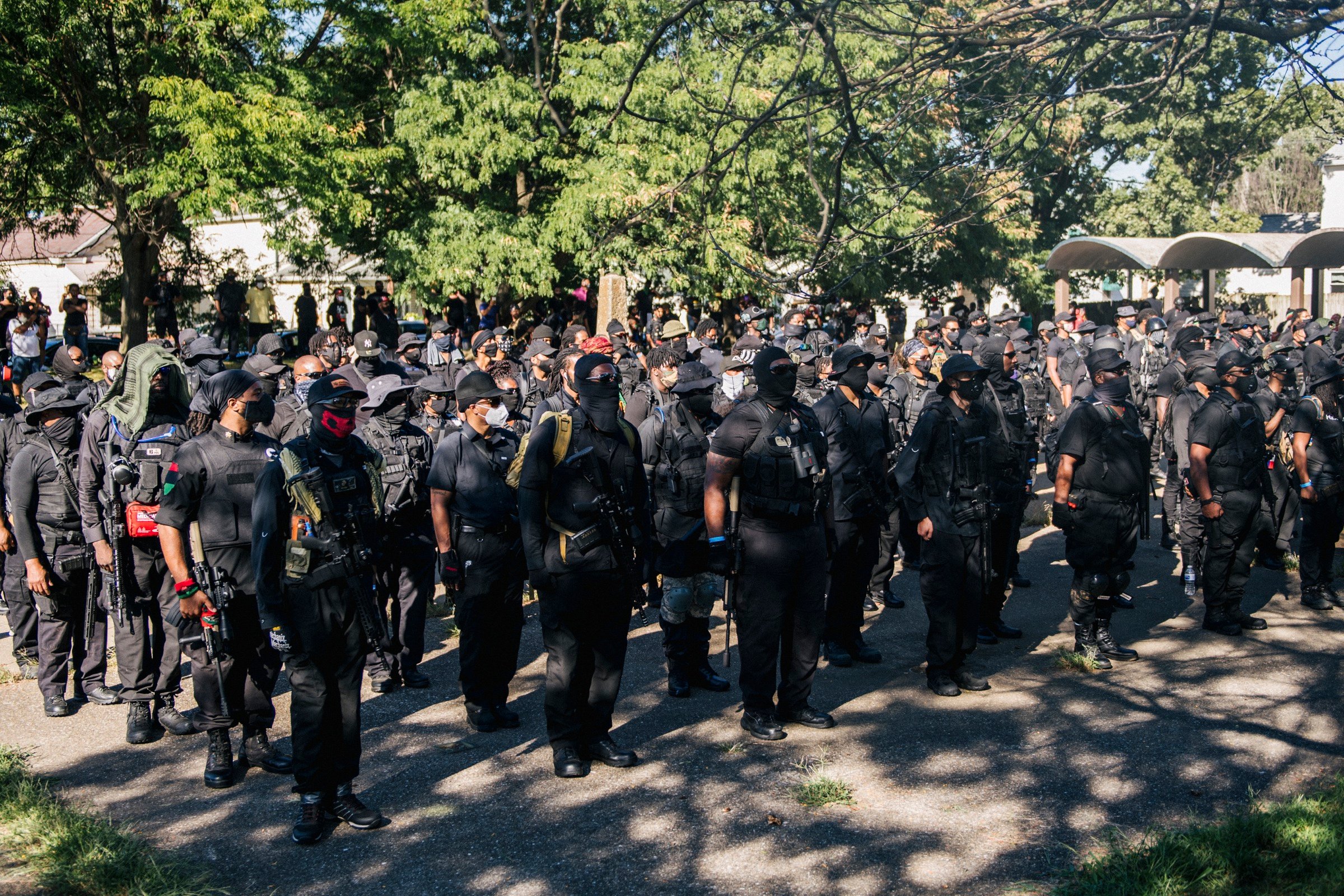
Discriminatory policies emerged in the form of licensing schemes, bans on cheap weapons, and targeted policing as a means to disarm and terrorize Black communities. In the South, white racial terror groups like the Ku Klux Klan offered extrajudicial means to deter Black gun ownership.
Still, armed Black organizations that challenge white hegemony are a fixture in American society, often forming in reaction to white supremacy, racial tensions, and hate crimes. Those organizations often face the full brunt of law enforcement, which relies on a federal court system that has been shown to treat Black men more harshly than their white counterparts.
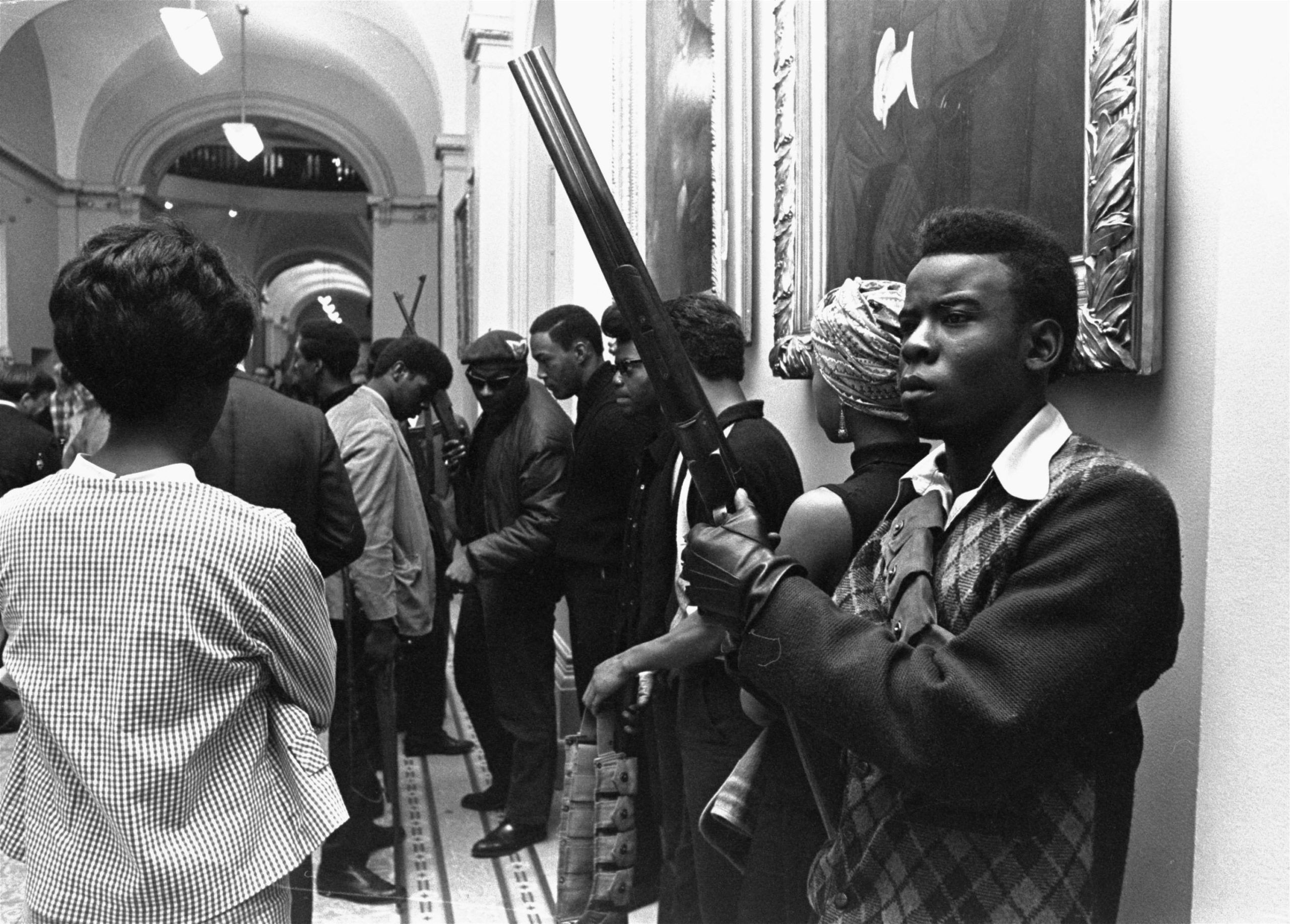
In the 1960s, the FBI infiltrated the Black Panther Party, whose supporters publicly carried firearms on neighborhood patrols to ensure police didn’t harass Black residents. Members of the Black Panthers were arrested, displaced, and killed.
The group’s armed demonstrations spurred the California Legislature to craft the Mulford Act, a law banning the open carry of loaded firearms. The bill received bipartisan support, was backed by the National Rifle Association, and was signed into law by Governor Ronald Reagan in 1967.
In 1985, MOVE, a Black armed collective living in a Philadelphia row house, was bombed by a police helicopter after the mayor declared the group a terrorist organization. The bombing killed six members and five children.
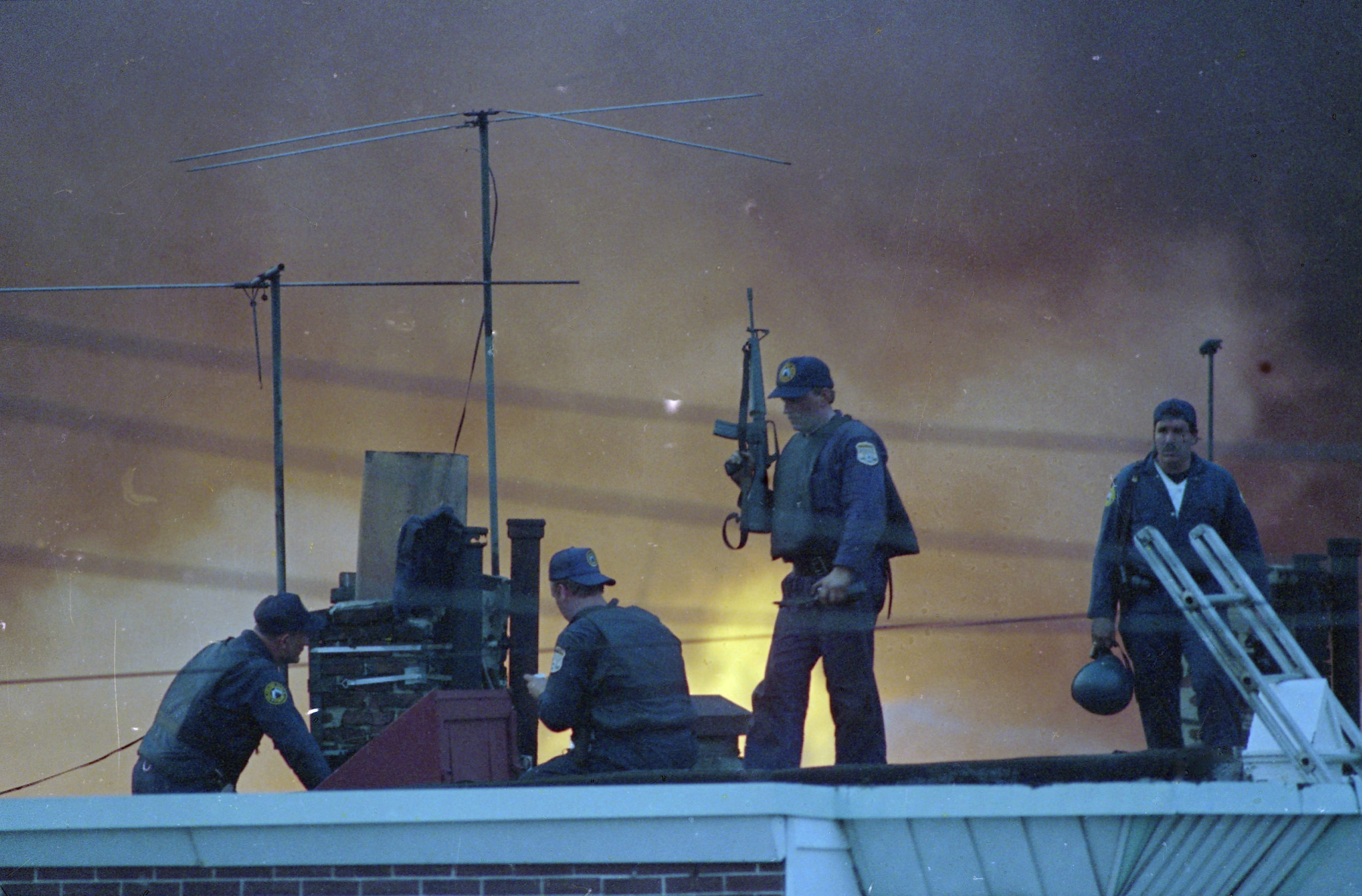
And in 2017, Rakem Balogun, former leader of the Huey P. Newton Gun Club, was arrested on federal gun charges and labeled a “Black Identity Extremist” by the FBI for organizing armed protests against police shootings in Dallas. The charges were eventually dropped.
“Law enforcement and the state historically prosecutes such groups more aggressively,” Tang said. “Black radicals will always inspire a level of fear that won’t be the same as when white militias arm themselves.”
A disproportionate response?
Over the last decade, right-wing militia groups like the Oath Keepers and the Three Percenters largely have been allowed to go about their business.
In 2020 and 2021, these armed groups – almost exclusively white – paraded across the nation, opposed Black Lives Matter demonstrations, and offered themselves as security at political rallies for former President Donald Trump and other Republican politicians. Like NFAC, their members typically carry loaded weapons.
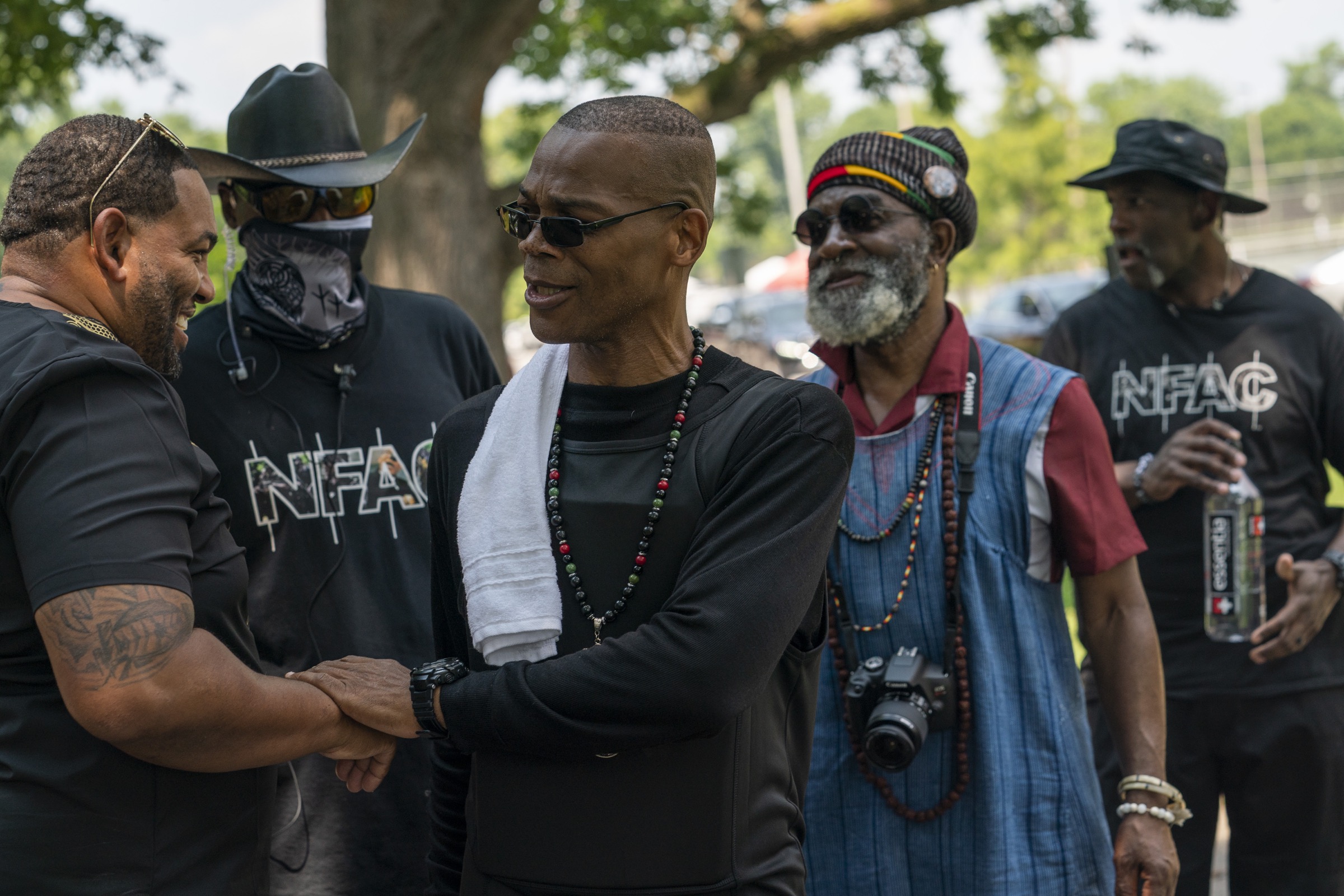
At events where militia members have gathered, people have been accused of aiming a rifle at Confederate monument protesters in Texas, pointing guns at Black Lives Matter marchers in Arkansas and attempting to invade the Oregon Capitol. In April 2020, eight months before Grandmaster Jay’s arrest, armed militia members occupied the Michigan State Capitol building.
Nobody involved in those incidents has been charged by federal prosecutors, though misdemeanor charges were brought against militia members in Arkansas and Oregon.
“There are a lot of cases where white militia members who are armed get a free pass,” said Daryl Johnson, a security consultant and former senior analyst for domestic terrorism at the Department of Homeland Security.
There are a lot of cases where white militia members who are armed get a free pass.
Daryl Johnson, security consultant and former senior analyst for domestic terrorism at the Department of Homeland Security.
All 50 states outlaw the existence of armed militias that aren’t authorized by the government. Some state constitutions contain clauses stating that such groups are illegal; others go as far as banning certain types of activity, like drills and marching in formation.
These laws are seldom enforced, however. Investigators and prosecutors typically step in when militia members cross a line – one that critics and experts argue is arbitrary.
“Prosecutors and the feds have a toolbox of strategies that they can use to go after organized crime,” said Mitchel Roth, a professor of criminology at Sam Houston State University. “The whole thing comes down to who they’re targeting.”
Some experts in militia movements say there’s no evidence Grandmaster Jay is being singled out.
MacNab believes federal prosecutors saw an opportunity to target a potentially dangerous group. She pointed out that white militia groups across the country have been infiltrated, investigated, and prosecuted dozens of times.
Mary McCord, executive director of the Institute for Constitutional Advocacy and Protection at Georgetown Law Center, agreed that the feds have thrown the book at white militia members who have faced off against law enforcement.
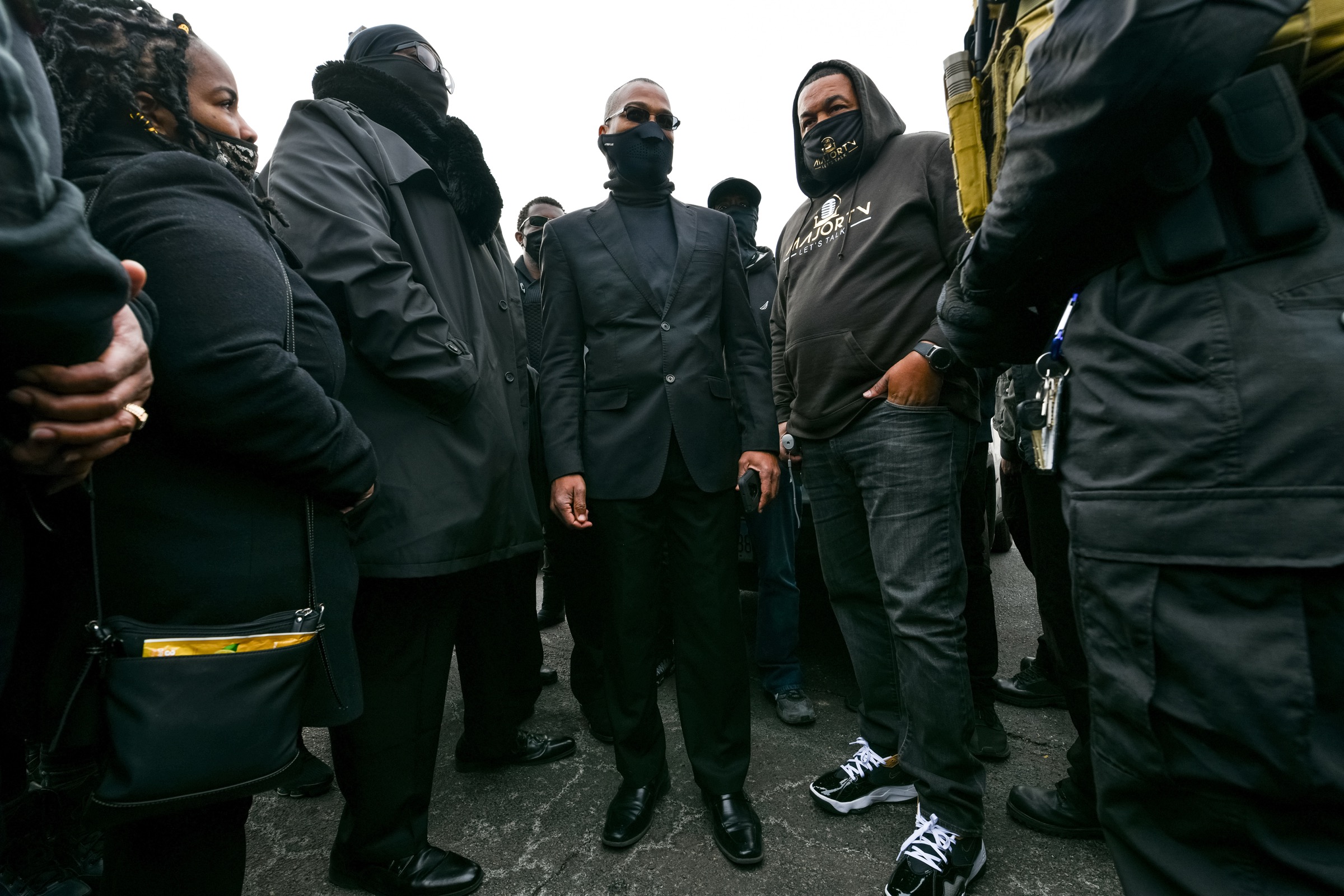
In addition to the Bundy Ranch and Malheur stand-offs, the most recent example is the Jan. 6 insurrection, which has led to the arrest of dozens of members of illegal militias.
“It certainly wouldn’t surprise me at all if there would be disparate treatment of a Black militia and a white militia,” McCord said. “But I don’t know if that case (against Grandmaster Jay) is emblematic of that.”
Grandmaster Jay doesn’t want to be ignored
On a steamy Saturday in late July, Grandmaster Jay strutted around Chickasaw Park in western Louisville.
The second event of NFAC’s “Drop The Charges Weekend,” a neighborhood picnic billed as “Feed The People,” was off to a slow start. The food was two hours late. A few NFAC members, most from out of town, milled around or posted up as security guards against couples strolling by and the occasional bass-thumping low-rider. Nobody could find the power cable for the speakers.
At one point, Grandmaster Jay gathered a dozen or so women off to the side. One of NFAC’s female members had reported a sexual advance from a man in the group, and Grandmaster Jay was having none of it.
He told the women to go to him with any complaints. The women responded, “Yes, sir,” and “No, sir.”
The moment of fealty, in a day marked by a sense of confusion and disappointment, provided an unfiltered window into how NFAC operates. Nothing happens within the organization without Grandmaster Jay’s say-so. And nothing continues if he deigns it to stop.
But Grandmaster Jay has no control over the case that has forced him to give up his gun and his online megaphone. That seemed an especially tough pill for this leader to swallow.
If he does go down, Grandmaster Jay said, he would be the latest in a long line of Black leaders struck down by a system that was biased against him from the start. He named civil rights leaders who got the attention of a nation and even spoke with the president of the United States: The Reverend Martin Luther King Jr. and Malcolm X.
“It would be intelligent,” he said, “for them not to ignore me.”
This story has been updated to include additional details about Grandmaster Jay’s public statements.
